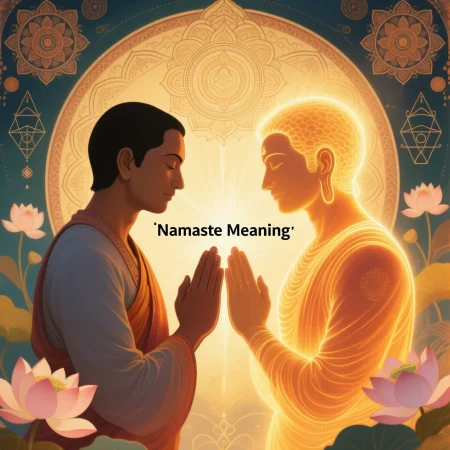The word Namaste carries a depth of history, cultural significance, and spiritual expression that extends far beyond its common use as a polite greeting. Today, it is heard in yoga studios, spiritual retreats, wellness circles, and daily life across India. But what does Namaste mean, and why has this ancient word captured the world’s attention?
This article takes a deep dive into the namaste meaning, its etymology, cultural and spiritual roots, and how it is interpreted in different languages and traditions. Along the way, we’ll explore its role in Yoga, its symbolism, and even common misconceptions surrounding its use.
Namaste
In the simplest sense, Namaste is a greeting—similar to “Hello,” “Welcome,” or “Respect.” But its definition goes much deeper than just a word exchanged at the start or end of a conversation. When someone places their hands together at the heart, bows slightly, and says “Namaste,” they’re expressing more than a casual acknowledgment.
It is a salutation that honors the divine spark in another person, an acknowledgment that both individuals share the same universal essence.
Etymology and Origin of Namaste
The origin of Namaste lies in Sanskrit, the classical language of India, often considered the “language of the gods.” The term can be broken down as follows:
- Nama → To bow
- As → I
- Te → You
Put together, Namaste literally translates as “I bow to you.”
In ancient Vedic texts, particularly in Hindu scriptures, Namaste appeared as both a linguistic context and a spiritual expression. It wasn’t just used for greetings, but also in prayers, mantras, and ceremonial rituals.
Namaste originated in India, yet over time, through Hinduism, Yoga, and cultural exchanges, it has traveled far beyond its birthplace.
Literal and Linguistic Meanings
Namaste’s translation differs slightly depending on the language and context. Below are its most recognized forms:
nglish
- Translation: “I bow to you”
- Interpretation: A polite, respectful way of saying hello or goodbye
- Often misunderstood as simply “hello,” when in fact it carries a deeper philosophical meaning of respect and unity
Meaning in Hindi
- Used daily in India as a greeting
- Can be heard in both urban and rural areas
- Often interchangeable with Namaskar, which carries the same essence but is considered slightly more formal
Sanskrit
- Root of the word
- Earliest usage in Vedic chants and mantras
- Directly tied to religious, philosophical, and spiritual traditions
Meaning in Urdu
- Adapted into cultural exchanges in India and Pakistan
- Written as “نمستے”
- While not part of Islamic tradition, it appears in dialogue and literature within regions of shared heritage
Spanish
- Translated as “Me inclino ante ti” or “Te saludo con respeto”
- Commonly used among yoga communities in Spanish-speaking countries
Japanese
- Often confused with Japanese greetings like “Konnichiwa”
- In reality, “Namaste” does not exist as part of Japanese tradition; however, Japanese practitioners of yoga may use it
Spiritual and Cultural Context of Namaste
Namaste is more than a linguistic translation—it’s a spiritual expression. Its essence lies in recognizing the divinity within every individual.
In Hinduism, Buddhism, and Jainism, Namaste is considered a salutation that acknowledges the soul within each person. By bowing with folded hands, one conveys humility and respect.
The Gesture (Anjali Mudra)
The Namaste gesture involves placing the palms together in front of the chest, fingers pointing upward. This is known as the Namaste Mudra or Anjali Mudra.
- Hands at the heart → Symbolize connection of soul and emotions
- Bow of the head → Sign of humility and respect
- Closed eyes (sometimes) → Suggest inward focus and spiritual acknowledgment
It is not just a physical action; it embodies a cultural meaning of Namaste that transcends words.
Namaste in Yoga
One of the most well-known contexts of Namaste today is within Yoga practice. In yoga studios worldwide, teachers and students end their sessions with Namaste.
Namaste in Yoga Meaning
- A gesture of gratitude from teacher to student, and student to teacher
- Acknowledges the shared spiritual journey of the practice
- Represents unity: body, mind, and soul coming together
Common Misinterpretations in the West
- Often thought of simply as a way to say goodbye after yoga
- Misused in commercial culture (printed on t-shirts, coffee mugs, etc.)
- Sometimes detached from its spiritual significance and reduced to a trend
Yet, when used authentically, Namaste in Yoga remains a powerful spiritual salutation that bridges ancient traditions with modern wellness.
Modern Usage Around the World
While Namaste began as an Indian greeting, it now has global recognition. In Western countries, it’s most often associated with Yoga, meditation, and mindfulness practices.
India vs. The West
- In India: A daily word of respect, often used when meeting elders or strangers
- In the West: More spiritual, often tied to yoga and wellness communities
Common Misconceptions
- Many assume it means only “Hello” when in reality, it holds philosophical meaning of respect for the soul
- Some view it as exclusively tied to religion, while others over-commercialize it
The truth lies somewhere in between: Namaste is cultural, spiritual, and personal all at once.
Namaste in Symbols and Writing
The Namaste symbol is usually represented through the Anjali Mudra gesture. However, visual depictions also appear in art, sculptures, and mandalas.
In written form:
- Namasté (with accent) is common in French and Spanish texts
- Namaste (standard) is used globally
- Script forms vary: Devanagari (नमस्ते), Urdu (نمستے), Romanized (Namaste)
This highlights the linguistic context of Namaste across cultures.
Misunderstandings and Cultural Sensitivity
While Namaste is widely celebrated, it’s important to recognize issues of cultural sensitivity.
When Not to Use Namaste
- As a casual replacement for “Hello” in Western slang
- In contexts where it may seem mocking or superficial
- Without understanding its cultural and spiritual significance
Respectful Use
- Saying it with sincerity and proper gesture
- Acknowledging it as part of India’s cultural heritage
- Avoiding its use in places where it may be out of context
This balance ensures it remains a respectful salutation, not a caricature.
Related Greetings and Alternatives
While Namaste is widely known, it isn’t the only respectful greeting in Indian culture.
- Namaskar → Slightly more formal, used in both daily and religious contexts
- Pranam → Often used when greeting elders, signifies deep respect
- Sat Sri Akal → Sikh greeting meaning “Truth is the timeless Lord”
- Vanakkam (Tamil), Pranamam (Telugu), etc.
These show that Namaste is part of a diverse landscape of greetings in India, each with its own cultural significance.
Conclusion
So, what does Namaste mean? At its core, it means “I bow to you.” But to reduce it to a mere definition misses its beauty.
- It is a linguistic expression rooted in Sanskrit.
- It is a spiritual salutation that honors the divine in others.
- It is a gesture that blends humility, respect, and unity.
- It is both ancient in origin and modern in global adoption.
Whether spoken in India, practiced in Yoga, or understood across the world, Namaste carries a message of oneness and respect that transcends language.
FAQs About Namaste
What is the simple English meaning of Namaste?
It literally means “I bow to you”, used as a polite greeting with deep respect.
Is Namaste religious or cultural?
It is both. Namaste is rooted in Hindu spiritual traditions but is also used culturally as a daily greeting in India.
Why do people bow when saying Namaste?
The bow, combined with folded hands, symbolizes humility and acknowledgment of another’s soul.
Can non-Indians say Namaste respectfully?
Yes, as long as it’s used sincerely and with an understanding of its meaning.
What’s the difference between Namaste and Namaskar?
Both mean a respectful greeting. Namaskar is often considered slightly more formal and traditional.



